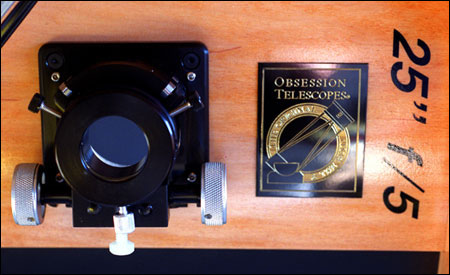Observatory opens deep space to all
New 25-inch telescope provides views of nebulas, galaxies

The Harvard-Smithsonian Center for Astrophysics is revealing deep space’s globular clusters, nebulas, and galaxies to the general public, opening the galactic skies with a new 25-inch outreach telescope that promises to bring smaller instruments’ distant blurs into astonishing clarity.
“Now we have a giant porthole into outer space,” said David Aguilar, the Center for Astrophysics (CfA) manager of public affairs.
Aguilar said the public reception for the new instrument, unveiled at a barbecue and viewing event on Oct. 16, has been tremendous. Already numerous community organizations, clubs, and professors have begun asking for time with the new telescope.
“This has just been a marvelous way to extend ourselves into the community,” Aguilar said.

The telescope is the latest addition to the center’s community outreach efforts. The CfA hosts a variety of events that aim both to open the organization’s doors to the community and to educate people about current space science. Outreach efforts range from campy sci-fi movies coupled with a lecture on the sometimes shaky science behind them to serious talks like the monthly observatory nights that feature viewing from the roof of the CfA’s Cambridge headquarters.
“The money for the project was part of a NASA public education grant,” Aguilar said. “It will greatly improve the public viewing experience.”
While the smaller telescopes used in Cambridge are acceptable for seeing the moon and the planets of our solar system, the more distant objects, such as the dumbbell nebula and the ring nebula, appear as disappointingly blurry smudges.
The new instrument, however, is large enough to make those distant, dramatic objects very clear.
“They’re as brilliant as a picture you see in a book,” Aguilar said.
The telescope is housed in a new building at the CfA’s Oak Ridge Observatory in Harvard, Mass., joining the facility’s Wyeth 61-inch reflector, and the 84-foot steerable radio telescope.
The building that houses the new telescope is also brand new, the result of many hours of volunteer labor that began in August.
Aguilar said the Public Affairs Office began making announcements during public events last summer that they needed help with construction of the telescope’s new home. The response was surprising, he said.

“People showed up with shovels and rakes, and with work gloves on,” Aguilar said, adding that work continued even through the summer’s rains.
The telescope originally wasn’t intended for Oak Ridge at all, however. Aguilar said the original plan was to install it at the CfA’s Whipple Observatory in Arizona, which, like the CfA’s Cambridge headquarters, also draws large crowds to public programs.
It soon became clear, however, that because Whipple sits on U.S. Forest Service land, the permits for the installation would require extensive reviews of as long as two years, Aguilar said.
So instead of having the telescope sit in a box somewhere, CfA officials decided to use it in Massachusetts, where demand for a new telescope is also high. Aguilar said they’re reviewing alternatives for the Arizona site and hope some decision can be reached soon.
“We just have too many people showing up for public viewing events. The folks stand in line for hours to look through the telescopes,” Aguilar said. “We’re going to use [the new telescope] as often as we can. We hope it’ll be a workhorse for us.”




